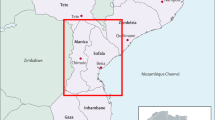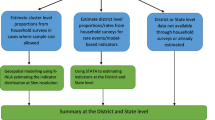Abstract
We describe our approach to develop a sampling frame for slum and non-slum areas using satellite data for an impact evaluation of a reproductive health and family planning program in six cities of Uttar Pradesh, India. The methods used in the paper were developed as part of the Measurement, Learning & Evaluation project (MLE) of the Urban Health Initiative (UHI) program in Uttar Pradesh (UP), India. Increasing access and use of high-quality modern family planning services, particularly among the urban poor, is a primary goal of UHI. Family planning use is associated with lower maternal and child mortality rates, and unintended pregnancies (Cates, Contraception 81(6):460–461, 2010; Cleland et al., Lancet 368(9549):1810–1827, 2006, Lancet 380(9837):149–156, 2012). To evaluate the UHI program in UP, India, a total of six cities were selected for the impact evaluation: Agra, Aligarh, Allahabad, Gorakhpur, Moradabad and Varanasi. This paper describes the methodology developed to design a representative population-based sample of slum and non-slum areas to be surveyed before, during and at the end of UHI program implementation to capture behavior changes among the urban poor, slum and non-slum residents. Geographic data for slums was obtained from the Remote Sensing Applications Center (RSAC). These data were combined with road networks, administrative boundary data and remotely sensed imagery to delineate the study cities into slum and non-slum primary sampling units using Geographic Information Systems.






Similar content being viewed by others
Notes
The Urban Health Initiative (UHI) India is a consortium of international, national, nongovernmental, and community-based organizations that work together with the government to improve the health of the urban poor funded by the Urban Reproductive Health Initiative (URHI) established under the Reproductive Health Strategy of the Bill & Melinda Gates Foundation. The initiative is comprised of reproductive health programs in four countries: Nigeria, Senegal, Kenya and Uttar Pradesh (UP), India. External evaluations of all four URHI programs are implemented by the Carolina Population Center at the University of North Carolina – Chapel Hill. More details on the program can be found at: http://www.urbanreproductivehealth.org.
References
Agarwal, S., Kaushik, S., & Srivasatav, A. (2006). State of urban health in Uttar Pradesh. Delhi: Urban Health Resource Center.
Agarwal, S., & Taneja, S. (2005). All slums are not equal: Child health conditions among the urban poor. Indian Pediatrics, 42, 233–244.
Angeles, G., Lance, P., Barden-OFallon, J., Islam, N., Mahbub, A., & Nazem, N. (2009). The 2005 census and mapping of slums in Bangladesh: design, select results and application. International Journal of Health Geographics, 8(32).
Bapat, M. (2009). Poverty lines and lives of the poor. Underestimation of urban poverty: the case of India. International Institute for Environment and Development (IIED). Poverty Reduction in Urban Areas Series: Working paper 20. IIED, London.
Cates, W, Jr. (2010). Family planning: The essential link to achieving all eight Millennium Development Goals. Contraception, 81(6), 460–461.
Chandrasekhar, S. & Montgomery, M. R. (2009). Broadening poverty definitions in India: Basic needs in urban housing. Paper prepared for the International Institute for Environment and Development (IIED). IIED, London.
Cleland, J., Bernstein, S., Ezeh, A., Faundes, A., Glasier, A., & Innis, J. (2006). Family planning: The unfinished agenda. The Lancet, 368(9549), 1810–1827.
Cleland, J., Conde-Agudelo, A., Peterson, H., Ross, J., & Tsui, A. (2012). Contraception and health. The Lancet, 380(9837), 149–156.
El-Zanaty, F., & Way, A. (2006). 2005 Egypt Demographic and Health Survey. Cairo, Egypt: Ministry of Health and Population, National Population Council, El-Zanaty and Associates;. Calverton, MD: ORC Macro.
Environmental Health Program. (2004). Situational Analysis Report of Agra City for Guiding Urban Health Program. Draft summary. http://www.uhrc.in/downloads/Reports/Agra-SA.pdf. Accessed: 7 Nov 2013.
Ezeh, A., Kodzi, I., & Emina, J. (2010). Reaching the urban poor with family planning services. Studies in Family Planning, 41(2), 109–116.
Gaur, K., Keshri, K., & Joe, W. (2012). Does living in slums or non-slums influence women’s nutritional status? Evidence from Indian mega-cities. Social Science and Medicine, 77, 137–146.
Government of India and Ministry of Housing and Urban Poverty Alleviation. (2010). Report of the committee on slum statistics/census. New Delhi: National Buildings Organization.
Guilkey, D., Speizer, I., Lance, P. (2009). Study design for the Measurement, Learning & Evaluation Project. Technical working paper 1-2009. Measurement, Learning & Evaluation Project, Chapel Hill, NC.
Gupta, K., Arnold, F., & Lhungdim, H. (2009). Health and living conditions in eight Indian cities, National Family Health Survey (NFHS-3), India, 2005–06. Mumbai: International Institute for Population Sciences; Calverton, Maryland, USA: ICF Macro.
Hazarika, I. (2010). Women’s reproductive health in slum populations in India: Evidence from NFHS-3. Journal of Urban Health, 87(2), 264–277.
International Institute for Population Sciences (IIPS) and Macro International. (2007). National Family Health Survey (NFHS-3), 2005–06: India: Volume I. International Institute for Population Sciences (IIPS) and Macro International. Mumbai, India: IIPS.
Jain, S. (2007). Use of IKONOS satellite data to identify informal settlements in Dehradun, India. International Journal of Remote Sensing, 28(15), 3227–3233.
Kholi, D., Sliuzas, R., Kerle, N., & Stein, A. (2011). An ontology of slums for image-based classification. Computers, Environment and Urban Systems, 36, 154–163.
Kit, R., Olek, S., Ludeke, M., & Reckien, D. (2012). Texture-based identification of urban slums in Hyderabad, India using remote sensing data. Applied Geography, 32, 660–667.
Map My India (MMI). (2009). Digital base maps of selected cities in Uttar Pradesh. New Delhi: MMI.
Montgomery, M. R., & Hewett, P. C. (2005). Urban poverty and health in developing countries: Household and neighborhood effects. Demography, 42(3), 397–425.
Nanda, P., Achyut, P., Mishra, A., Calhoun, L. (2011). Measurement, Learning & Evaluation of the Urban Health Initiative: Uttar Pradesh, India, Baseline Survey 2010. Technical Working Paper 3-2011. Measurement, Learning & Evaluation Project, Chapel Hill, NC.
Rooban, T., Joshua, E., Rao, U., & Ranganathan, K. (2012). Prevalence and correlates of tobacco use among urban adult men in India: A comparison of slum dwellers vs non-slum dwellers. Indian Journal of Dental Research, 23(1), 31–38.
Rutstein, S. (2008). Further evidence of the effects of preceding intervals on neonatal, infant and under-five-years mortality and nutritional status in developing countries: Evidence from the Demographic and Health Surveys. Working paper No. 41, Macro International, Calverton, MD.
Speizer, I. S., Nanda, P., Achyut, P., Pillai, G., & Guilkey, D. (2012). Family planning use among urban poor women from six cities of Uttar Pradesh, India. Journal of Urban Health, 89(4), 639–658.
Stoler, J., Daniels, D., Weeks, J., Stow, D., & Coulter, L. (2012). Assessing the utility of satellite imagery with differing spatial resolutions for deriving proxy measures of slum presence in Accra, Ghana. GIScience & Remote Sensing, 49(1), 31–52.
Stow, D., Lopez, A., Lippitt, C., Hinton, S., & Weeks, J. (2007). Object-based classification of residential land use within Accra, Ghana based on QuickBird satellite data. International Journal of Remote Sensing, 28(22), 5167–5173.
Taneja, S., & Agarwal, S. (2004). Situational analysis for guiding USAID/India and EHP/India: Technical assistance efforts in Indore, Madhya Pradesh, India. Activity Report 133. http://www.ehproject.org/PDF/Activity_Reports/AR-133-IndoreSituationAnalysis.pdf. Accessed 7 Nov 2013.
Tangri, A. K. (2009). Identification and Integration of Information on Slums and Non-Slum Clusters in Fourteen Cities of Uttar Pradesh using Remote Sensing & GIS Techniques. Mimeo. Lucknow: Remote Sensing Application Center.
UHABITAT. (2013). Building capacity and strengthening partnership between national statistical offices and local authorities to monitor the Millennium Development Goals Slum target in the context of natural disasters and housing crisis in Africa, Asia and Latin America. http://www.unhabitat.org/content.asp?cid=8247&catid=422&typeid=61. Accessed 5 Oct 2013.
UN Department of Economic and Social Affairs, Population Division. (2013). World population prospects: The 2012 revision, key findings and advance tables. Working Paper No. ESA/P/WP.227. United Nations, New York, NY.
UNHABITAT. (2002). Proceedings from the Expert Group Meeting on Urban Indicators: Secure Tenure, Slums and Global Sample of Cities. October 28–30, Nairobi, Kenya. UNHABITAT Urban Secretariat & Shelter Branch, United Nations Statistics Division and Cities Alliances. http://citiesalliance.org/sites/citiesalliance.org/files/expert-group-meeting-urban-indicators%5B1%5D.pdf. Accessed 5 Oct 2013.
World Bank. (2013). Poverty and equity data. http://povertydata.worldbank.org/poverty/home/. Accessed 5 Oct 2013.
Zulu, Eliya M., Donatien Beguy, A., Ezeh, P., Bocquier, N., Madise, J. Cleland, & Falkingham, J. (2011). Overview of migration, poverty and health dynamics in Nairobi City’s slum settlements. Journal of Urban Health, 88(Supplement 2), S185–S199.
Acknowledgments
The authors gratefully acknowledge support from the Bill & Melinda Gates Foundation for the Measurement, Learning & Evaluation project, the evaluation component of the Urban Reproductive Health Initiative, and for general support from the Carolina Population Center (R24 HD050924).The authors also thank the Remote Sensing Application Center for providing data used in this project.
Author information
Authors and Affiliations
Corresponding author
Rights and permissions
About this article
Cite this article
Montana, L., Lance, P.M., Mankoff, C. et al. Using Satellite Data to Delineate Slum and Non-slum Sample Domains for an Urban Population Survey in Uttar Pradesh, India. Spat Demogr 4, 1–16 (2016). https://doi.org/10.1007/s40980-015-0007-z
Published:
Issue Date:
DOI: https://doi.org/10.1007/s40980-015-0007-z




